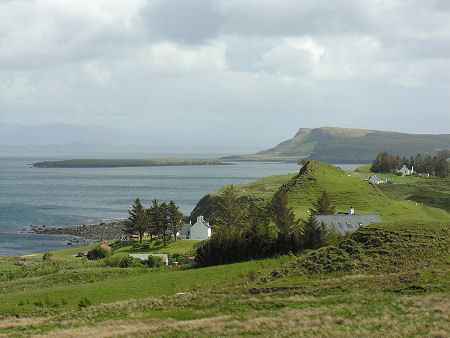 Flodigarry on the Isle of Skye |
Martin Martin, or in his native Gaelic, Màrtainn MacGilleMhàrtainn, was probably born on the Trotternish Peninsula at the northern end of the Isle of Skye in 1669, though both the date and location of his birth are the subject of continuing debate. He was that rarest of men, a native of Gaeldom who wrote about his native land for the benefit of a wider audience. The picture in Scotland at the time is set out in our Historical Timeline.
Martin seems to have come from a fairly well-off background, probably from a family of tacksmen: tenants responsible for an area of land that was in turn subdivided and sublet to others. His brother certainly seems to have been a tacksman at Flodigarry on Trotternish. Martin would have been brought up within a Gaelic-speaking community, though he would probably also have been taught Scots as a child and he went on to study at Edinburgh University. Carrying on the "may have been" theme of his life story, it is possible that after his formal education he returned to Skye to act as tutor for the children of the Macdonalds of Sleat and the MacLeods of Dunvegan.
Some time in the mid-1690s, Martin met members of the Royal Society and, apparently, was convinced of the need for a first hand account of the society, the culture and the natural history of the Western Isles. He visited and mapped St Kilda in 1697, part of a larger project with John Adair to map the Hebrides more fully. One result was his publication in 1698 of A Late Voyage to St Kilda, the text of which can be read here. The better known outcome of his wider travels was the publication in 1703 of Martin Martin's classic book: A Description of the Western Islands of Scotland. You can read the full text of his book, linked to relevant Undiscovered Scotland features, online here.
Martin's book stayed in print for over a century after its initial publication, assisting later travellers like Thomas Pennant, James Boswell and Samuel Johnson. The book was revived, with a special edition being printed in 1884 as background for the members of the Napier Commission or the Royal Commission of Inquiry into the Condition of Crofters and Cottars in the Highlands and Islands. It has since been republished in 1934, 1970, 1999 and, to mark the tercentenary of its original publication, in 2003.
Later readers of Martin's book, especially Boswell and Johnson, were critical of aspects of it. He seems to have relied on hearsay for much of his material, and possibly overemphasised what he referred to as curiosities of art and nature. He was certainly not above the odd wry observation of some of those he met on his travels, noting, for example, that the residents of Berneray (now uninhabited, lying south of Barra) who depended on the sea for their but the natives never go a fishing while Macneil or his steward is in the island, lest seeing their plenty of fish, perhaps they might take occasion to raise their rents. Martin also committed to print the lack of cooperation of the Constable of Kisimul Castle which prevented him visiting the castle.
Martin Martin disappeared from sight for some time after the publication of his book. He reappeared when he registered to study medicine at Leiden University in March 1710. After graduating, he practiced as a doctor in London until his death in 1719.
